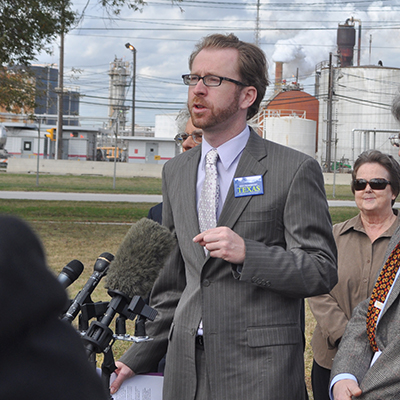
No fracking wastewater in our rivers! No on HB 2771 (Lozano)
Don’t buy claims that oil and gas wastewater is clean. Fracking wastewater contains highly toxic substances that can persist in the environment for many years. It can potentially contain any combination of over 1600 different chemicals. In one analysis of fracking fluid chemicals, 157 were found to be linked to reproductive or developmental health problems, and toxicity information was lacking for hundreds of others. Naturally occurring underground chemicals include oil byproducts, which can cause kidney and liver damage and reproductive problems, and radioactive materials, which can cause lung and bone cancer, lymphoma and leukemia.
Dear Chairman and members, I’m here today in opposition to HB 2771. At first blush, the bill seems innocuous – just transferring authority from the Railroad Commission to the Texas Commission on Environmental Quality over wastewater discharges from oil and gas. However, oil and gas companies don’t currently discharge to our rivers and streams and this bill would set us on a path to allow them to. The EPA generally doesn’t allow for these kind of discharges except in a few cases. This bill would seek permission to allow discharges before the EPA has even finished studying the issue.
Rivers are a big part of what makes Texas special. They are a source of clean drinking water. They are a place families can go to escape the heat and go swimming, tubing, fishing. And they are home to wildlife, like fish, turtles, and ducks.
Unfortunately, too many of our rivers are polluted. According to the TCEQ, 9000 miles of Texas rivers (or 40% of the total) are unsafe for swimming and fishing. We need to do all we can to clean up our treasured rivers and that’s why we are alarmed by this bill.
Don’t buy claims that oil and gas wastewater is clean. Fracking wastewater contains highly toxic substances that can persist in the environment for many years. It can potentially contain any combination of over 1600 different chemicals. In one analysis of fracking fluid chemicals, 157 were found to be linked to reproductive or developmental health problems, and toxicity information was lacking for hundreds of others. Naturally occurring underground chemicals include oil byproducts, which can cause kidney and liver damage and reproductive problems, and radioactive materials, which can cause lung and bone cancer, lymphoma and leukemia.
Of the as many as 1600 different chemicals in produced water, EPA has approved methods for detecting only about 400 of those chemicals. Next, we only have data on the toxicity for less than 200. And finally, the Safe Drinking Water Act regulates for just 89 of those.
For example, look at ethylene glycol, the main ingredient in antifreeze and a toxin to humans and animals. It’s one of the top 10 most used chemicals in hydraulic fracturing – repeatedly showing up in produced water, yet, it is not one of the chemicals regulated by the Safe Drinking Water Act. That means treated produced water could meet drinking water standards even where ethylene glycol is present. We need to proceed cautiously on whether, and how, to allow oil and gas wastewater in to our rivers. We can look to the 1920s, when oil was struck at the Santa Rita No 1 well on land owned by UT, about the dangers of managing this waste in ways we don’t fully understand the impacts. Wastewater then was managed by releasing it directly onto West Texas soil, before the industry and regulators fully realized the negative consequences of this practice. About one billion barrels of wastewater were spread across 2000 acres, creating the Texon Scar, a patch of dead earth so large it can be seen from space. That land is still being clean up today, almost 100 years later.
This experience should serve as a cautionary tale as you consider new ways to dispose of or use wastewater. We should not leap before we look very, very closely.
I agree that produced water is a potential resource we should put to work, but instead we should reuse it within the oil field. We have the technology to recycle this wastewater, but only a fraction is being recycled. A 2011 UT study calculated that only about 2 percent of flowback in the Permian Basin is recycled and reused. That amount has likely increased since then, but we don’t have the data and it probably is still no higher than 10%. Let’s require that this wastewater be recycled for reuse in the oil field, that would help conserve potable water and mean less wastewater is injected underground.
Authors
Luke Metzger
Executive Director, Environment Texas
As the executive director of Environment Texas, Luke is a leading voice in the state for clean air and water, parks and wildlife, and a livable climate. Luke recently led the successful campaign to get the Texas Legislature and voters to invest $1 billion to buy land for new state parks. He also helped win permanent protection for the Christmas Mountains of Big Bend; helped compel Exxon, Shell and Chevron Phillips to cut air pollution at four Texas refineries and chemical plants; and got the Austin and Houston school districts to install filters on water fountains to protect children from lead in drinking water. The San Antonio Current has called Luke "long one of the most energetic and dedicated defenders of environmental issues in the state." He has been named one of the "Top Lobbyists for Causes" by Capitol Inside, received the President's Award from the Texas Recreation and Parks Society for his work to protect Texas parks. He is a board member of the Clean Air Force of Central Texas and an advisory board member of the Texas Tech University Masters of Public Administration program. Luke, his wife, son and daughters are working to visit every state park in Texas.

